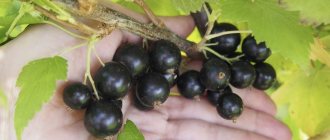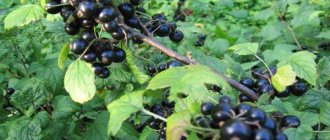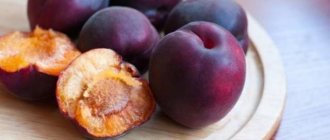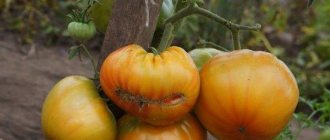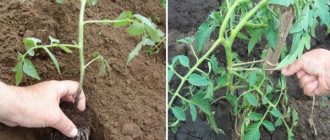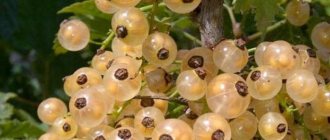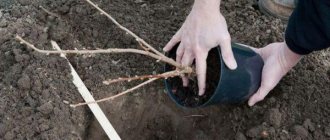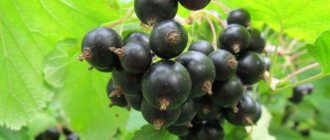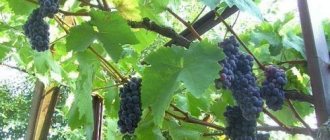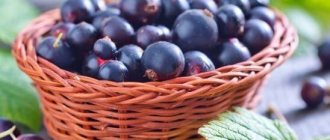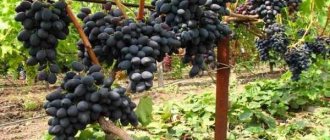Description of the currant variety Black Boomer
Black boomer currants, when properly cared for, bring a large harvest. The berries, which number about twenty on one branch, are distinguished by their large size and unusual taste.
This berry variety is distinguished by large berries that can weigh more than seven grams. They are dense to the touch and have a glossy tint. Currant pulp has a uniform consistency and is distinguished by a sweet taste and pleasant aroma. Three-lobed dark green leathery leaves are clearly visible on the bush.
Bushes occupy a special place in the description of the Black Boomer currant. They are straight, thick and straight branches are clearly visible, on which beautiful clusters hang. To prevent them from creeping along the ground under the weight of the harvest, it is recommended to tie them to improvised trellises.
Currants gained popularity due to their high and early harvest. The bushes begin to bear fruit around mid-summer.
A distinctive feature of this variety is the dry separation of the berries from the stalk. Ripe berries can remain on the bush for a long time without falling to the ground.
Early varieties
Lovers of early berries and those who strive to become market leaders choose early ripening currants. Preference is given to those with the shortest ripening period in the conditions of a given region. If, in the climate of Siberia, you plant a bush intended for zoning in the Krasnodar Territory, then there will be no berries in June. So the focus on zoning is very important. Popular early varieties of black currant:
- Akur is a highly frost-resistant productive crop for the Far East, regions of Siberia and the North-West. The taste rating is relatively low - 3.5 points out of 5.
- Treasure is a variety bred in Siberia. It is distinguished by its large fruit, pleasant taste and aroma. Currant treasure is demanding of moisture.
- Gulliver - this variety is highly resistant to drought and frost. Zoned in the Central and Northwestern regions, suitable for cultivation in the middle zone. Large currants received a rating for tasting qualities of 4.5 points.
- Gift of Smolyaninova - recommended for cultivation in the Central regions of Russia.
- Dachnitsa is a popular variety grown in households in the North-West region. It is distinguished by a delicate taste, rated by tasters at 4.7 points, thin skin and berries, weighing 2.2 grams.
- The Slastena variety of early black currant is distinguished by excellent taste and high frost resistance. It is not susceptible to fungal diseases, which is important - it is resistant to pests.
- Maria Kyiv is ideal for those who want to get early, fairly large marketable berries. Due to early ripening, the fruits do not have time to gain sugar content, which is excusable for early products. Zoned in Ukraine, but can also be grown in the Central regions of Russia. Frost resistance -32°C.
- Nester Kozin is a shrub that is optimally grown in the middle zone, winter-hardy, and productive. The advantage of the variety is its high resistance to powdery mildew. The taste of the fruit is sweet and sour. 7 kg of berries from the bush.
- Exotic - the variety is distinguished by a fairly strong growth of shoots, zoned in the central regions. Not afraid of frost. Productivity is low. The taste indicators of the Exotic early black currant are 4.3 points.
Advantages and disadvantages
Not only the external qualities of the berry can be attributed to its advantages. It differs from its relatives in its early ripening and abundant fruiting. The pulp of the berry has a slight sourness, due to which currants are often used for confectionery purposes.
Under favorable weather conditions, currant bushes can bear fruit several times a season. The berries ripen evenly regardless of their location to the sun. Thanks to the hard work of breeders, currants are resistant to various diseases and are practically easy to care for.
The disadvantages of this variety include loss of taste due to drought and a large number of weeds. Sometimes the skin of the fruit may be hard or cracked even when not fully ripe.
Harvesting and transportation, keeping quality of berries
Berry picking lasts approximately 20 days. It depends on the number of varieties and their ripening period. Typically, a worker harvests an average of 20–30 kg of crop per day. You shouldn’t delay the work, because in this case they may crumble and lose their taste. It is recommended to pick currants in the afternoon, when the sun sets, or in the morning, when the dew subsides. Can be collected in cloudy weather. You should not do this in the heat or during rain, then the product will deteriorate faster. It is necessary to use one container and not pour the currants into other containers, so as not to spoil the appearance. If the berries are going to be transported, they are picked off in not fully ripe bunches and placed in baskets or boxes with a capacity of up to 6 kg. The transportation itself should not exceed one week.
The harvested crop is stored in a cool place for the period of transportation or direct use. The Black Boomer currant variety grows well in Ukraine and Russia. Gardeners leave positive reviews and note its endurance, early growth and good yield. With proper care it can bear fruit several times.
How to plant seedlings?
Currants are considered long-lived: they are accepted very quickly and begin to bear fruit the very next day. It is best to plant berries in early autumn or late spring. You can buy seedlings in a store or at the market from summer residents. But before buying, you need to carefully examine them: they must have a good root system and no fractures.
Black boomer currants are planted in well-drained acidic soil. If necessary, you can add a little lime, organic fertilizers, and granular superphosphate to the soil. Bushes must be protected from the wind.
When planting, you need to follow some recommendations from experienced gardeners:
- The hole for the root system of the bush should be at least half a meter wide and deep. They are made at a distance of at least a meter to provide sufficient space when growing.
- Black soil is added to each hole, and to prevent burns of the root system, a little soil is sprinkled on top. This is done about a week before planting so that the soil settles well.
- The seedlings are placed in the hole at an angle of five degrees. The root collar should be deepened by about five centimeters.
- To form young roots, the root system is carefully spread over the entire hole.
- Carefully pour in the soil and compact it. Pour about half a bucket of water into each hole and sprinkle with a thin layer of earth and humus.
- You need to make a small groove around the planted bush and fill it with water.
- Trim each seedling with garden shears so that it protrudes above the ground by about twenty centimeters. Be sure to make sure that there are at least two buds left on the cutting.
Judging by the reviews of summer residents, the Black Boomer currant will bear fruit well and withstand weather conditions if it is planted next to another variety of currant. Their cross-pollination has a beneficial effect on the growth and taste of the berry.
Reviews
You can find a lot of reviews about this variety of currants; for example, a resident of the Moscow region states:
- Black boomer currants, when properly cared for, bring a rich harvest that can be harvested several times a season.
- The berries have a pleasant sour taste, which gives an unusual taste to baked goods. A refreshing fruit drink in hot weather will appeal to all family members.
A gardening enthusiast from the Krasnodar region writes: Black boomer is an unpretentious plant that takes root well in any climate. Even in dry weather, with irregular watering, you can collect large ripe berries. A distinctive feature of this variety is their simultaneous ripening, which allows you to harvest the entire harvest at once.
Commenting on reviews that some currant bushes do not bear fruit well, a summer resident from Novosibirsk writes: I believe that it is possible to collect large and ripe berries only with proper care. Pruning should be done in spring and autumn. Treat against pests, fertilize the soil. And in the summer, water as needed with the addition of organic fertilizers.
Black boomer currants, according to most gardeners, are considered a high-yielding variety that does not require much time for care. Every year it gains great popularity due not only to its taste, but also to its ability to bear fruit in different climatic zones.
You can learn more about the Black Boomer currant variety by watching the video:
“Black Boomer” currants were obtained by crossing very popular and sweet-fruited varieties of this berry crop – “Chudesnitsa” and “Selechenskaya II”.
Reviews from gardeners
“Black Boomer” is a very highly productive variety of chokeberry, unpretentious in care and one of the most drought-resistant, which makes it popular for cultivation in regions with high temperatures and an almost complete absence of rain for a long time.
Reviews from gardeners about this currant are in most cases very positive. Summer residents note such advantages of the variety as high resistance to pests and diseases, as well as the early fruiting of the plant, which makes it possible to harvest the first harvest in the second year after planting the seedlings in a permanent place.
Description and characteristics
The black currant variety is characterized by early harvest formation and very large berries, the weight of which reaches 6-7 g. The berries are one-dimensional, with a fairly dense pulp consistency, covered with a glossy skin. Berry bunches look very attractive. The taste of ripe berries is excellent. The pulp at the stage of full ripeness is characterized by sweetness and a very pronounced aroma. The advantage of this currant is the dry release of the berries.
The bushes are powerful, upright, but very compact. This variety compares favorably with other sweet-fruited varieties in its unpretentiousness and increased resistance to damage by the most common diseases of chokeberry. The yield is very high and stable from year to year. Peak fruiting occurs in mid-summer. A fully ripe berry remains on the bushes for a long time, crumbling a little when it is very overripe.
Let's say a word about Boomer Black: characteristics, description
Description of black currant variety Black Boomer - without commercial notes, following objective reviews and unbiased opinions, brief description.
Black currant Black Boomer (seedling Chudesnitsa x Selechenskaya-2) was bred in Kharkov, Ukraine by M.P. Uzenov, a talented gardener and variety tester, who created more than a dozen bright, sweet-fruited productive varieties. Unfortunately, like many others, it has not yet been included in the State Register, has not passed variety testing, but has been tested by farmers, who have confirmed in practice the numerous advantages of the variety. Used in amateur gardening, in small-volume production, in commercial areas as a supplement to the main leading varieties.
Early, ripening time - early June, in the south of Ukraine - approximately June 10-12 in some years. Productivity – true productivity is not recorded. Approximately high, at the level of worthy parent varieties mentioned above.
In the photo, the Black Boomer currant is the author’s hand. The photo above shows a bush bearing fruit for the first year. Not a lot, but not bad for a start.
- The habit of the bush is upright, the growth force is intense. It is recommended to tie the plants to an improvised trellis or stakes so that the branches do not lie down. However, a non-leaning bush does not need special support - but for branches that are strong but bend under the weight of berries, it is better to organize it. Regarding the height and area of fruiting, sometimes on young plants of the current year (seedlings of autumn planting) the top of the central shoot is pinched to stimulate the growth of the second order of branching. This is done in June so that abundant growth forms before the fall, the basis for the future harvest.
- The leaf is wrinkled, not hard, leathery, three-lobed, dark green. The blades are long, with large notches, and sharp. The teeth are slightly beveled, quite large, not sharp - slightly rounded. The leaf blade is folded upward along the three main veins in the shape of a boat.
- The berries are large and very large, weight from 2-3 g to 5-6 g (depending on agricultural technology, age of the bush), dense, very uniform in average weight, with black glossy skin, collected in medium-sized clusters. According to reviews, the size of the largest specimens can be as large as a 10-kopeck coin (Ukrainian), sometimes even larger – the size of a small cherry. Anticipating delight, we will be disappointed: individual ones, with fairly high agricultural technology. According to responses, the size is comparable to Selechenskaya-2, Venus, slightly smaller than Yadrenaya.
- The pulp is dense, quite juicy, very sweet, with little perceptible sourness, a bright dessert taste, extraordinary and memorable. The skin is of medium strength, semi-dry (dry at technical maturity).
- Disease resistance is quite high.
Advantages
Let's start with the pleasant - the advantages are visible to the naked eye.
- Early ripening, friendly fruiting;
- Sweet dessert taste is one of the best among modern large-fruited ones, balanced, with a bright good aroma, excellent product quality;
- Early fruiting, compressed, not extended fruiting;
- High productivity - no reliable recorded data, but in terms of responses, comparable to leading commercial varieties. However, according to visual assessment, it is inferior to Big Ben, Selechenskaya (according to other estimates - comparable to it), but exceeds the old garden varieties.
Disadvantages of Boomer
- Moderate drought and heat resistance in the conditions of the north-east of Ukraine, the center and the south - according to some reviews, attacks without shading at peak temperatures, sufficient watering, etc. are often observed in particularly hot years. It is recommended to arrange the rows from east to west, use compacted planting at a distance of 60-80 cm, drip irrigation, and shading to shade each other with bushes. To be fair, very few varieties can boast of true heat resistance - part of the Scottish selection, part of the Russian selection - the same Yadrenaya, etc.;
- In comparison with some modern large-fruited varieties, the skin is durable, sometimes harsh, but prone to cracking in some years, when dry torn off - according to some farmers, as a private opinion. According to other reviews, the peel is wet (semi-dry, with full ripening in some years or on overripe berries), the skin is thin and tender: perhaps in some cases there is misgrading - the variety does not correspond to the true one, in others there is a lack of microelements. In general, the fruits are distinguished by good density with average skin strength and semi-dry tearing (wet at full ripeness, overripe), transportability;
- Selechenskaya-2 is somewhat inferior in productivity - according to some reviews, in size, disease resistance;
- In critically hot years, it may crumble slightly without shading or sufficient watering;
- Overripe fruits, under favorable conditions, do not fall off for a long time, but, according to reviews, they somewhat lose their sweetness, dry out, and become sour.
Terms and rules for planting seedlings
Planting chokeberry “Black Boomer” has some nuances:
- higher yields and the formation of larger berries are observed if several different varieties are planted nearby, which stimulates mutual cross-pollination;
- currants of this high-yielding variety can be planted both in autumn and in spring, but the most favorable time for planting prepared seedlings is considered to be autumn;
- planting of seedlings with a closed root system is carried out in more extended periods, spring-summer planting is recommended to be carried out in April-June, and autumn planting of seedlings is best done in September or October;
- any black currant is quite demanding on soil fertility, therefore it grows and develops poorly when cultivated in wetlands and too acidic soils;
- the area allocated for growing black currants must be as smooth and free from weeds as possible; special care should be taken when removing wheatgrass;
- approximately one and a half to two months before planting prepared chokeberry seedlings, it is necessary to add organic fertilizers to the soil in the form of manure, compost or peat, and then carry out deep digging of the soil;
- when planting, seedlings should be placed at a standard distance of at least 1.5-2 m in a row, which will not only make it easier to care for adult plants, but also improve the nutrition of black currants;
- planting holes or trenches should be dug in advance, maintaining a depth of 35-40 cm and a width of at least 50-60 cm.
Seedlings must be placed in the planting hole in an inclined position, keeping the angle of the plant at approximately 45 degrees. To obtain high productivity of a berry bush, it is very important to deepen the root collar of the seedling by about 8-10 cm, which will allow you to obtain a more powerful bush with numerous well-developed shoots.
Immediately after planting, if necessary, pruning is carried out, and then the plant is watered abundantly at the rate of one and a half buckets of water for each seedling. It is advisable to mulch the soil with organic matter.
Plant care
How to care for black currants:
Caring for black currants involves timely pruning, watering, weeding and fertilizing. Since the bush wakes up in early spring, it is necessary to have time to trim branches and remove buds that are affected by pests. You should carefully examine the branches of the plant, and if there are too many affected buds, you will have to completely trim the bush.
If the plant is healthy, you can prune it to create a beautiful shape. The ground around the currants needs to be dug up, but this should be done in such a way as not to damage the roots. You can mulch the area around the bush after loosening.
No less important is the spring watering of black currants and the application of nitrogen fertilizers. The granules are poured to a depth of 8 cm per 10 g. Per 1 m2.
When the currants begin to bloom, inspect the flowers and remove double ones according to their appearance.
During the ripening of the berries, weeds are removed under the bushes and the plant is provided with the necessary amount of moisture. Lack of water can cause the berries to fall off and dry out.
After picking the berries, the bush is watered abundantly and fertilized with potassium mixtures, and the soil underneath is loosened.
In autumn, they prune the branches, removing and cutting off all weak or damaged ones. Mature bushes should consist of 15 healthy branches of different ages with developed buds. Every year it is recommended to leave 1-2 fresh shoots, and cut off 7-year-old branches. Proper pruning in the fall is the key to a good harvest next year.
Despite the fact that “Black Boomer” is a winter-hardy variety, care should be taken to protect it in cold weather. Metal surfaces should not be used to cover branches. The metal will transmit the cold and cause possible freezing.
It is best to tie the branches and cover them with a wooden board, tiles or bury them. The instillation method is used in particularly cold climate zones, where the temperature often drops below 35 degrees. It is also permissible to use covering material.
How to care for currants (video)
According to the observations of experienced gardeners, the variety produces super-large berries in weight and size, the average weight of which, with proper agricultural technology, is at least 7-7.2 g. The berry is not only large, but also very attractive in appearance, but can crumble a little from the heat. However, in general, this is a very worthy variety for home gardening, and the high content of fructose in ripe berries allows it to be classified as one of the best dessert varieties that children really like.
Every gardener wants to grow only the best varieties of plants in his garden plot. To get good blackcurrant harvests on your plot, it is recommended that you read the article.
Despite the advice of experts to plant only zoned varieties of currants, gardeners give preference to the largest and sweetest varieties. Fortunately, breeders are not sitting idle, and now black currants can grow in every region; varieties of super large, sweet and fruitful (description, photo) berries can now be grown very easily.
Variety selection
It is recommended to choose varieties of domestic selection. Firstly, they are in no way inferior to their foreign counterparts, and secondly, they are more suitable for the climate and soil of Russia.
- Variety Pearl . Mid-early variety of black currant. The main fruiting begins in mid-June. The bushes are of medium height, rarely exceeding 1 m. The average weight of the berries is 5 grams. It has a pleasant dessert taste and characteristic aroma. Can be used to make jams, preserves or fresh. The yield is consistently high; more than 3 kg of berries can be harvested from each bush. The variety is characterized by increased resistance to very low temperatures and drought. Among the negative aspects, extremely low transportability should be noted.
It should be noted that the blackcurrant varieties described above can produce a good harvest and show high yields if all conditions for full growth are met. Violations of care rules, freezing, prolonged drought, disease and other negative factors can greatly affect the quality of the crop.
The main condition is a sufficient amount of moisture. If the bushes do not have enough moisture, then their berries will not be able to gain sufficient size, and their taste will leave much to be desired. The roots of currant bushes are very close to the soil surface. In summer, it quickly dries out, and the roots are left without moisture. Therefore, the main condition for growing grapes is frequent watering.
All berry plants love feeding, and black currants are no exception in this regard. Properly selected fertilizers will help gardeners enjoy a large amount of tasty harvest, and the plants themselves will remain healthy and have good immunity.
The most valuable berry in the garden plot is black currant; varieties of super large, sweet and fruitful berries (description, photo) are provided above. By choosing one or several varieties at once, you can provide yourself with an unlimited supply of vitamins and nutrients.
Dacha forum: dacha, garden, vegetable garden, flowers.
Dacha forum: about the dacha, about flowers, about your garden plot
- Unanswered messages
- Active topics
- Search
- our team
Status: Offline
"Black BMW"
A variety of black currant with very large berries weighing up to seven grams. The variety is early, the harvest is harvested in early June. Large shiny brushes look like grapes and have the same exquisite aroma.
- uniform ripening;
- the clusters have equal-sized, dense berries that tolerate transportation well;
- very sweet taste;
- the berries do not fall off after full ripening;
- It does not require special care;
- resistant to diseases.
So far, this is the only blackcurrant variety on our list that has no downsides. Many summer residents and gardeners believe that the “Black Boomer” variety is a new era in the development of this fruit and berry crop. So far, this type of crop is suitable not only for the largest, but also for the sweetest varieties of black currant.
A variety of black currant with large, about three grams, berries. More than three kilograms of harvest can be harvested from one bush. Early variety. The attitude of summer residents towards him is ambiguous.
Drought and frost resistance
Drought is detrimental to the grape harvest, as is excessive watering:
- at too high temperatures, dry air and lack of watering, the ovary develops poorly, crumbles, and does not fill with juice;
- a period of prolonged rains at the last stages of ripening can affect the amount of sugar in the berries and lead to their cracking.
Therefore, it is important to regulate the watering process.
Video “How to water Laura grapes. Comparison with the Arcadia variety"
In regions with mild, snowy winters, bushes are not covered. If the expected temperature drop is below -23 °C, the vine is removed from the trellis and covered with agrofibre in several layers or buried in soil.
Since the variety is characterized by average susceptibility to gray rot, mildew, and sometimes picks up oidium, if neighboring bushes become sick, then preventive treatments are necessary:
Pruning and shelter for the winter
Such a procedure as shortening the shoots of a young bush does not apply; it is carried out only in the 3rd year after planting. Grapes are pruned in the fall, when they begin to bear fruit. Weak and unnecessary shoots must be removed; no more than 3-4 strong branches should remain on the bush. In addition, the number of eyes on the shoots should not exceed 40-50 pieces. Unpruned young vines often die from frost in winter. You should not be zealous, otherwise next year the yield will decrease.
When cultivating Laura grapes in the southern regions, where there is no threat of severe frosts (above 23 degrees), there is no need for additional shelter.
When grown in cold climates, after harvesting, you need to carefully cover the bushes with a layer of mulch or other material. But first you should remove the damaged shoots. Before covering the vines, it is good to treat them with a lime-based solution, which will help reduce the likelihood of them freezing.
